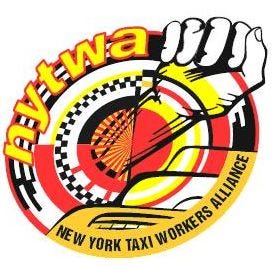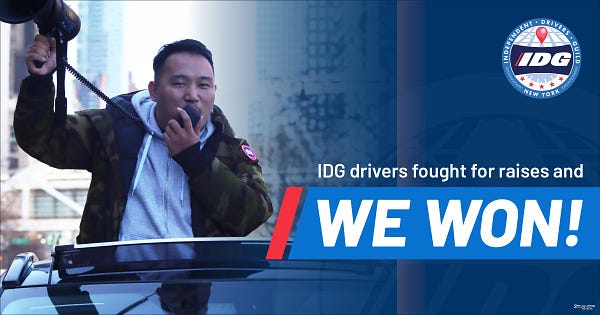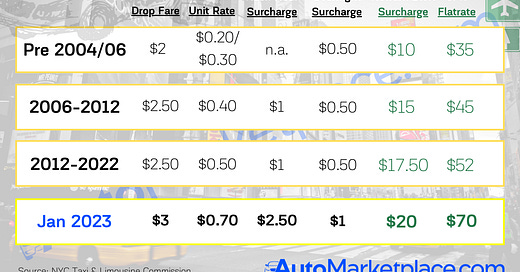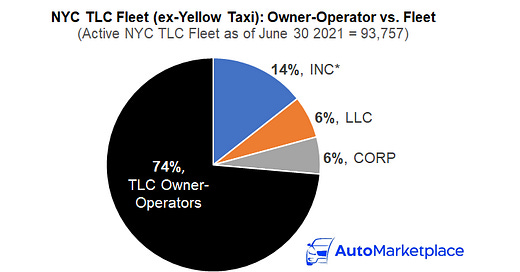

Discover more from AutoMarketplace
🙋 NYC TLC Approves Yellow Cab Fare Hike & Increase To Uber/Lyft Minimum Pay Standard
Taxi & Limousine Commission approves first taxi rate increase in a decade and increases Minimum Pay Standard for NYC Uber & Lyft drivers. New pay rates will be implemented by year end
⏱️Summary
🚕 Yellow cab taximeter rates are increasing for first time in a decade: The NYC Taxi & Limousine Commission (TLC) voted to increase yellow cab taximeter rates. Passenger fares are projected to increase by 23% & driver gross revenue by 33%. New pay rates should be implemented by year end.
💵 NYC TLC wants yellow taxi drivers to return: Although trip demand has grown, yellow cab drivers have been slow to return. Driver pay increase, hopes to financially incentivize drivers to return to work.
🚖 Yellow taxi medallion value will likely benefit: New pay raise will likely increase yellow cab lease rates, which actually benefits taxi medallion value.
📈 Driver Minimum Pay Standard increased to reflect inflation: The TLC also voted to increase the driver Minimum Pay Standard, which only applies to Uber & Lyft drivers in NYC (aka High Volume For-Hire Services bases). Per minute rate increases 7% & 24% per mile, equating to $27.15 gross minimum pay. These pay rates should also be implemented by year end.
🧮 Utilization requirements return for Uber & Lyft in NYC: Uber & Lyft in NYC (only High Volume For-Hire Services bases), will be subjected to utilization rates (i.e., roughly time driver spends doing trips ➗ total online time on App).
🤔 Congestion pricing politics shouldn’t be ignored: Benefits of TLC driver pay raise can be undone by additional congestion tolls on NYC FHVs.
Firstly, and as a quick note, we apologize for the delay in providing a more timely update as the NYC Taxi & Limousine Commission’s (TLC) livestream wasn’t working yesterday. We wanted to fully review and share (you’ll see some clips below) footage from yesterday’s Commission meeting.

The TLC, which hosted its first in person meeting since the beginning of the COVID pandemic, approved the first taximeter (aka yellow cab fare) increase in over a decade, while also approving an increase to the Driver Minimum Pay Standard that NYC High Volume For-Hire Services (HVFHS) bases must abide by. Given, Uber and Lyft are the only HVFHS bases, the increased minimum pay standard only applies to Uber & Lyft, not other bases, a point which we will briefly discuss towards the end of this piece. Although an exact date for the new pay standards to become active wasn’t given, the TLC has guided that the new standards will be implemented by the end of this year 🗓️.
Yellow Cab Fare Increase, TLC Goals & Potential Impacts
Using NYC TLC provided information, presented by TLC Assistant Commissioner for Policy James DiGiovanni during yesterday’s meeting, we put together a chart (see below) summarizing NYC’s yellow cab taximeter fare history, including the recently approved increase. According to TLC’s analysis, the average taxi ride will cost $19.62 with the new taximeter compared to $15.97 today. Also of note is the 35% price increase in the JFK/Manhattan flat fare from $52 to $70 and the addition of a $5 surcharge for trips to LaGuardia (LGA) airport 🛬.
The TLC did a nice job summarizing how they came up with the proposed yellow cab fare increase. It’s worth watching the full ~15 minute presentation (Click here for the link. We’ve included some short clips below as well). TLC Assistant Commissioner for Policy DiGiovanni notes several interesting data points, including how NYC taxi fares compare to other American cities and NYC public transport. The TLC also makes clear that one of the core goals of the taximeter fare hike is to financially incentivize more TLC drivers to drive yellow cabs.
As we recently wrote, thousands of taxi medallions remain inactive.
Taxi Medallion Valuation Impact
From the medallion debt restructuring program (MRP) to the continuation* of the FHV License Pause (aka TLC Plate Cap) to the announcement that all FHV Licenses in storage must be removed by next August to this taximeter fare increase, yellow cab 🚕 medallion values should start recovering.
Without getting into too much granular detail here, we know via speaking to several long time industry operators that the current yellow taxi market dynamic has shifted to single shift drivers who rent a yellow cab & medallion 24/7. Current medallion (including vehicle) lease rates are between $800 to $1,100 per week, which is about 50% below the medallion lease cap thresholds of ~$2,000 per week. This ~$2,000 per week was historically split between two 12 hour shift drivers (i.e., each driver paid ~$1,000 per week to rent a medallion plus vehicle). As NYC trip demand continues to recover with driver pay increases plus the TLC Plate Cap bringing back FHV supply scarcity - medallion values are set to increase, as higher lease rates become more sustainable 📈.
🤔 Now, you may think organizations like the New York Taxi Workers Alliance (NYTWA) might be against this, BUT individual medallion owners will benefit from higher lease rates as that leads to higher medallion values. No one likes to pay more for something, but in this instance it’s a bit more complex where the aim is actually to get back to the lease cap rate threshold, especially if it’s being driven by drivers earning more. If you argue to lower lease caps, you will devalue the taxi medallion. The yellow cab industry and its advocacy groups, must not make short sighted arguments to lower lease cap rates, as they may unintentionally impair the value of their own medallions!
Note: Recently, a one-time 1,000 EV-only FHV License exemption was announced, but our reading of that announcement is that the industry shouldn’t expect that to be a recurring new FHV license dynamic
NYTWA Wants $25 Per Hour NET PAY
Finally, it’s also important to note the NYTWA, an influential TLC driver advocacy group led by Bhairavi Desai, believes taximeter rates are still too low and plans to continue to advocate for taximeter rates that result in $25 NET pay per hour (pay after all expenses), which is likely a gross wage of between $35 to $45 per hour.
If we’re being honest, one has to be careful not to demand such a steep wage increase where you destroy yellow cab trip demand in a meaningful way. However, we appreciate the goal is to ensure drivers are earning a NYC living wage. For reference, a $45 per hour gross wage would be 3x (triple) the City’s current minimum wage.


"The work still remains to get driver income to $25 per hour after expenses. And we still have too many trips such as e-hails for yellow cabs and out-of-town trips for Uber drivers where drivers earn less than they spend. We're going to take the momentum of this driver raise which comes despite company opposition and after a long delay, and use it to power our fight for a job with dignified incomes, job security and retirement."
- NYTWA Executive Director Bhairavi Desai
Pay Raise For NYC Uber & Lyft Drivers
In addition to the taximeter increase above, the TLC Minimum Driver Pay Standard that High-Volume For-Hire Services (HVFHS) are subject to, was increased. Uber and Lyft are the only HVFHS bases in NYC, or bases that have over 10,000 trips per day. The per minute rate increased by 7.4% and the per mile rate increased by 23.9%, which is estimated to result in a $27.15 gross minimum pay standard. Remember, this is the minimum pay for an NYC Uber and Lyft driver, they still have the opportunity to earn more. In addition, utilization rate formulas were re-introduced and re-formulated to, presumably, lessen the chances of lockouts. The utilization rate range is now 52% to 64% to ensure TLC drivers receive sufficient trips while on either the Uber or Lyft apps (i.e., not idling). It’s hard to exactly understand how the new formula will work in preventing app “lockouts”, but we’ll write more about it as we understand it better.
Impact On Traditional Black Car & Livery Bases
Another point worth considering is if Uber & Lyft are forced to pay their drivers higher wages, would that actually accelerate trip demand destruction for non-Uber/Lyft bases. For example, could traditional black car and livery bases pay their drivers $27.15 per hour? If they can’t, wouldn’t they continue to lose drivers to Uber/Lyft. Even new services like Revel, which employs drivers but takes care of all expenses, might have difficulty competing with Uber and Lyft. Maybe we’re wrong, but it’s just a thought that crossed our minds as those bases argue for “base-specific” TLC Plates. Are more plates really going to solve their problem if they can’t compete on pay? Obviously, we understand they’ll be exceptions to this statement.
We know the above thought won’t make us popular 😠 in the black car & livery base communities and we are happy to reconsider our assumption. Please let us know if you think we are unfairly characterizing the dynamic (please comment below or email us at info@automarketplace.com)
Concluding Thoughts
Yesterday, many TLC drivers celebrated a long fought battle for better pay. Yellow cabs drivers getting their first pay raise in a decade seems long overdue and perhaps an annual inflation-tied wage increase can help avoid a one-time large absolute increase (we understand this is a goal of many yellow taxi advocacy groups as well). Honestly, trip demand may go down as passenger fares increase to support increased driver pay and that is not something that should be ignored. For example, Uber spokesperson Freddi Goldstein seemed to voice trip demand concerns in response to yesterday’s TLC Commission decision. At the same time, we also appreciate that doing work that pays less than a livable wage is also unsustainable, whatever trip demand impacts occur.
“While moving away from dynamic pay rates was long overdo, passing a rule that expressly says it wont be guided by economic reality going forward hurts riders, drivers and the agency’s credibility”
- Freddi Goldstein, Uber spokesperson
The Taxi & Limousine Commission, under Chair Do’s leadership, is doing a lot of things right and they should be commended for that. It’s easy to criticize, and we won’t hesitate to do that when we believe it is deserved, but it’s also important to commend a job well done. We also believe tightly regulating FHV supply (aka TLC Plates) is very important, as this directly impacts all TLC drivers’ earnings. That being said, when the data indicates there is a need for additional TLC Plates, the regulator should also not hesitate to act, but we think that reality is at least several years away.
Finally, the next major hurdle for NYC TLC drivers and all industry participants will be to unite, to ensure TLC vehicles aren’t subject to additional congestion tolls. This hard won wage increase will essentially be all for nothing, if the MTA decides to unfairly double tax NYC TLC drivers and passengers.



As always, let us know your thoughts in the comments section below or by emailing us at info@automarketplace.com.
AutoMarketplace.com NYC covers the for-hire transportation industry and automotive news. Check out AutoMarketplace.com on YouTube ▶️












